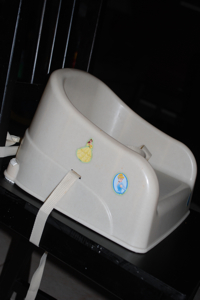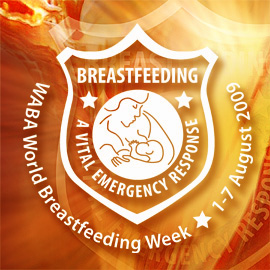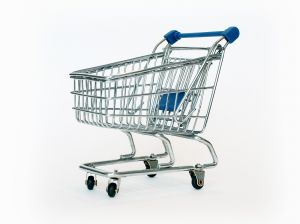
“Stay in Your Seat!” Teaching Your Toddler How To Eat With the Family
 My 2 year old daughter, Annabelle, is a grazer. She doesn’t eat a meal in one sitting. Instead, she takes a few bites, leaves it, plays, and comes back for a few a bites more. It can take her 3 hours to eat 5 chicken nuggets. If we are at a park she will carry her sandwich around with her. Of course, I know this is a problem that I partly helped to create.
My 2 year old daughter, Annabelle, is a grazer. She doesn’t eat a meal in one sitting. Instead, she takes a few bites, leaves it, plays, and comes back for a few a bites more. It can take her 3 hours to eat 5 chicken nuggets. If we are at a park she will carry her sandwich around with her. Of course, I know this is a problem that I partly helped to create.
I want my daughter to eat and if that means that it took her a few hours to eat, so be it. Right when she wakes up from her nap I would serve her dinner, so she could get a head start. It never seemed like she ate enough, so I let the problem begin by letting her eat whenever she wanted.
We also had a problem with her easily getting in and out of her seat. For a while booster seats and high chairs became like hot molten lava and she wouldn’t touch them. So we let her sit on her knees in a regular chair. When we went to restaurants she didn’t want to stay seated at all. I was so worried one night that she was going to touch her tomato sauce covered hands on our neighbor’s white shirt. We got a booth whenever possible to corral her.
Last week my husband and I were ready to tackle this issue. We have 2 goals to teach our 2 year old.
1. To learn to eat with the family.
2. To stay seated while she ate.
We were ready to stick out whatever tantrums and protests she threw. She needs to learn how to eat with the family.
- We bought a new booster seat
 The first thing I did was buy a new booster seat. I decided on a backless seat that does not have a tray. I don’t need the back to support her and she uses the table like the grown-ups to eat. The seat I bought is a Safety First brand for $10.50 at Wal-Mart.
The first thing I did was buy a new booster seat. I decided on a backless seat that does not have a tray. I don’t need the back to support her and she uses the table like the grown-ups to eat. The seat I bought is a Safety First brand for $10.50 at Wal-Mart.
That evening I attached the booster seat to a chair. I had her help me attach the seat. Next, I got some Disney Princess stickers and let her put a few on her seat wherever she chose. The whole time I kept saying in a very enthusiastic tone, “This is Annabelle’s Princess Chair!”
- Everyone eats together
That same day I waited to feed her dinner until my husband and I could sit down with her. She was so hungry she was already sitting in her chair, before I even served dinner. She stayed seated the whole time! She even ate almost everything I gave her and stayed in her seat until after we left the table. The booster seat was a big hit! Apparently, a part of her problem was that she wasn’t comfortable sitting at the table in a regular chair. Now she calls her seat “Annabelle’s Chair.”
- Use the “All Done” rule
In addition to the chair, I have reinstated the “All Done” rule. When she was a baby I taught her the sign for “all done.” Now we ask her if she is all done. If she says yes, we immediately take her out of her seat, wash her hands, and put her plate away. I will let her have liquids after dinner, but after that there is no more until the next meal. She remembers this rule from before, so it hasn’t really been an issue.
We were ready for tantrums and protests, but didn’t get any. What a thrill it is to have a tackled a behavioral problem successfully. I know that all them won’t be this easy, but I am counting my blessings for this one!
Have you had a problem with getting your toddler to stay seated? Do they eat really slowly? What problem are you currently tackling?
Share the fun: Email + Del.icio.us + Digg + Technorati

 I live in San Antonio, TX, home to the Alamo, warm weather, and Mexican food. Naturally, a cold margarita goes with the latter two. When I was pregnant with my first child all I wanted was a cold, sour, lime margarita from
I live in San Antonio, TX, home to the Alamo, warm weather, and Mexican food. Naturally, a cold margarita goes with the latter two. When I was pregnant with my first child all I wanted was a cold, sour, lime margarita from 


 Several of my friends have been discussing with me how they are tightening up their monthly budgets. We have been doing the same in our house. We live in a pretty small house for having three children and I am happily trying to spend less money so we can move into a little larger home hopefully soon after the first of the year! One area of our family’s budget which we have a lot of control over is our grocery bill. We include diapers, toiletries, and cleaning items in our grocery bill and have budgeted about $500 a month on grocery items. While that is not very much money for a family of five, with one on Pediasure, it’s a very doable number for our family. However, I am trying to get that number even lower!
Several of my friends have been discussing with me how they are tightening up their monthly budgets. We have been doing the same in our house. We live in a pretty small house for having three children and I am happily trying to spend less money so we can move into a little larger home hopefully soon after the first of the year! One area of our family’s budget which we have a lot of control over is our grocery bill. We include diapers, toiletries, and cleaning items in our grocery bill and have budgeted about $500 a month on grocery items. While that is not very much money for a family of five, with one on Pediasure, it’s a very doable number for our family. However, I am trying to get that number even lower!



